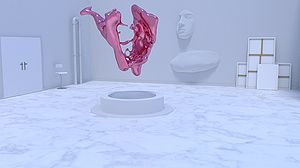Idle Self
Idle Self is a work by Tom Hancocks. It is an interactive online exhibition that features a virtual house that users can explore. Each room has a different piece featured in GIF form.

Artist: Tom Hancocks
Year: 2013
Medium: Interactive website
Formal Analysis
Users are presented with a virtual house, with the title Idle Self written on its front. The main doors must be clicked in order to enter the house, and once inside, users click on doors to navigate to different rooms. Each room contains a recurring GIF, and in the rooms that are set up as an exhibition, the central "artwork" for that room exists in the form of a GIF. The GIFs/artwork, as with many of the objects inside the house, are abstracted objects. Hancocks' clean and fluid aesthetic gives each object and seamless GIF a realistic appearance, rendering them indiscernible from real physical objects. He combines both abstracted objects with existing objects, such as one room that features a splash of a red translucent liquid as the central GIF, while a stack of canvasses lays against the wall.

Subject Analysis and Interactivity
Hancocks explicitly describes Idle Self as an online exhibition, with his intent being the exploration of the GIF format.[1] The title Idle Self suggests that the viewer who visits his online exhibition is the "idle self", as the viewer simply clicks on doors to move through the space, putting in minimal effort to explore the virtual gallery. And because viewers must click within the gallery, viewers are turned into users.
This type of interactive presentation of artwork provides a way for anyone with internet access to visit Hancocks' exhibition. It is an easy way for people to find and view artwork. However, this ease may be exactly what Hancocks is criticizing with this piece. While image searches and the increasingly popular use of smartphones and the internet to view virtual galleries fuses modern technology with institutionalized spaces (i.e. museums, galleries) to create accessibility to any artwork, it makes viewers lazy and perhaps even less appreciative of the artwork, as opposed to attending a real gallery. The act of physically attending a gallery and interacting with a piece, not through a computer screen, is an experience that is incomparable to any online exhibition.
References
Author
Kathleen Escanan, 2014